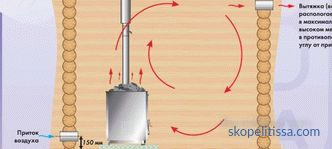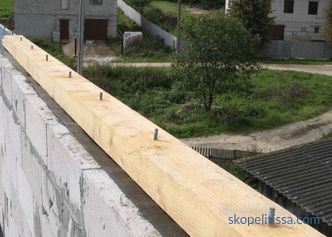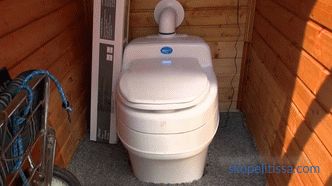In this article we will talk about what a heating cable is for a roof, what it is for, how to choose it and install it correctly. Having studied the information provided by us, you will understand what exactly the masters are doing, who will be engaged in the installation of the anti-icing system, and you will know whether they offer the cable for installation on the roof of your house.
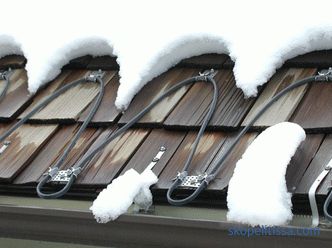
Why do you need a heating cable
The situation with icicles and pieces put on, which fall down, demolishing everything that comes across on its way is not uncommon. There are two ways to avoid tragedy:
-
to constantly clean the roofs of buildings and structures from the snow mass;
-
install a heating cable for the roof.
The second option is simpler in all respects, but it has one requirement - the presence of electricity as a power source. That is, it turns out that the electric current passing inside the cable is converted into heat. The cable heats up and melts snow. The water slowly flows down the drainage system, not forming icicles and ice.
Types of heating cables
Today, manufacturers offer two types of cables for heating the roof: resistive and self-regulating.
Resistive
This cable was the first invention in anti-icing systems. In fact, it is a copper conductor in a plastic sheath, on top of which a shield wire is laid in the form of a grid (it also acts as grounding). On top is another protective plastic layer.
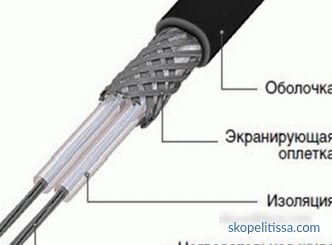
This type works as a normal conductor, in which the greater the resistance, the more thermal energy is released. From the school course of physics we show the formula of electrical resistance:
R = S ,
where p - metal density, L - conductor length, S - cable cross-sectional area.
It turns out that the longer the cable, the higher the density of metal used in the manufacture, but the smaller the cross-section of the wires, the more the cable will generate heat. With the accuracy of the above parameters, the resistance will be the same for the entire length of the plotted area. So, the resistive conductor emits thermal energy over the entire length in the same quantity.
For roof de-icing systems, this is not the best indicator. The thing is that the laid conductor is exposed to snow and the ice is not the same in length. At some part of the snow layer is large, some part without any snow cover. And the heat goes all over the conductor equally. That is, the cable can not react to the load, changing the amount of heat generated. Therefore, in some areas, heat is wasted. This is the main drawback of heating cables for gutters and roofs.
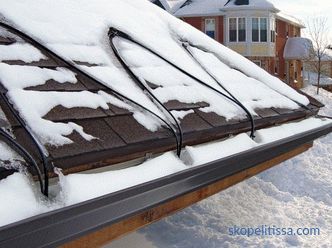
Resistance cable is produced in two types today: serial and zonal. They differ from each other in design features.
On our website you can find contacts of construction companies that offer the service of making calculations and performing electrical work of any complexity. Directly to communicate with representatives, you can visit the exhibition of houses "Low-rise Country".
Serial
This is one lived in a plastic sheath, as described above, go two-core product, in which a current flows in different directions along two wires. In this way, electromagnetic radiation is leveled. That is, increases the safety of operation under voltage.
To increase the length of the heated section, pieces of heating cable are connected in series. At the same time, pay attention to the formula, the resistance of the conductor decreases, which means that its heat transfer also decreases.
Zonal
These are two-core wires, the conductors of which are interconnected by a nichrome thread. She wound in a spiral around the wires, connecting alternately with one vein, then the other. The connection is made through special so-called contact windows. Thus, the heating cable for the roof is divided into heat transfer zones.
The plus of this variety is the ability to cut the conductor into areas that will work independently. In addition, in conjunction with other zones, if one of them is damaged, the rest will work.
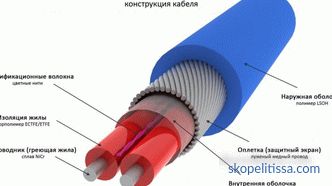
Self-regulating cable
If you look at the design of the heating cable of the self-regulating for heating the roof , it practically does not differ from resistive twin-core. The only addition is the matrix, to which two cores are connected. The matrix is a semiconductor layer that reacts to changing ambient temperature.In this case, its resistance changes first: the higher the temperature, the lower the resistance. Accordingly, less heat is generated.
It turns out that the conductor itself regulates the supply of electric current to one or the other area depending on the temperature of the air or snow. This makes it possible to further save on current consumption.
The only negative is the high price. It is 2-4 times higher than the resistive one.

On our website you can find contacts of construction companies that offer a number of construction services without prepayments. Directly to communicate with representatives, you can visit the exhibition of houses "Low-rise Country".
Anti-icing system
Heating of drains and roofs is not just a heating cable. The system additionally includes:
-
wire that supplies power to the heating element;
-
power supply;
-
thermostat and RCD;
-
fasteners;
-
couplings.
The efficiency of the system depends on the thermostat. This device regulates the flow of electric current depending on the ambient temperature. Therefore, temperature sensors are additionally installed in the design. The simplest thermostat is dual-band. It only works to turn on and off the anti-icing system.
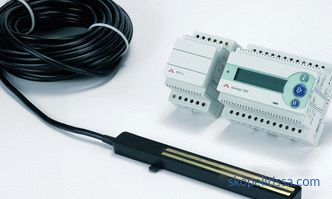
A more advanced option is the so-called weather station. It monitors not only the temperature, but also other parameters, such as air humidity, which directly affects the formation of ice on the roofs. Weather stations operate on the basis of the programmed parameters, hence a good saving in voltage consumption - up to 80%.
Installation of anti-icing system
So, we can conclude that the heating cable is self-regulating for the roof - the best option, but expensive. As for the methods of installation, all the varieties presented here are not different from each other.
-
At the edge of the overhang, the laying is made by a snake, the width of which varies between 60-120 cm. If the roof is covered with metal tile or corrugated flooring, the installation is carried out on each lower wave.
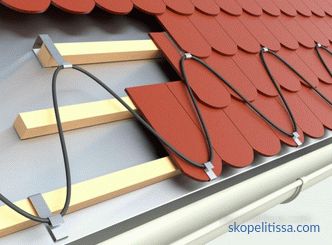
-
On the end lines, the cable is laid in two parallel sections along the roof element. The distance between them is 30-50 cm.
-
The same applies to the horizontal gutters of the drainage system and vertical pipe risers.
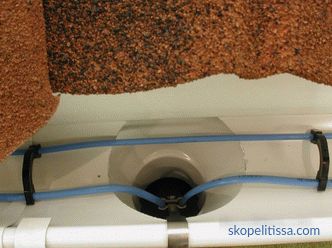
Pay attention to how the cable should be placed in the receiving The funnel is an element between the chute and the pipe, as well as in the drain pipe located at the very bottom of the riser pipe. These two elements are the most exposed to the load from the melt water. Therefore, inside them heating cable is placed in rings or in the form of a falling drop.
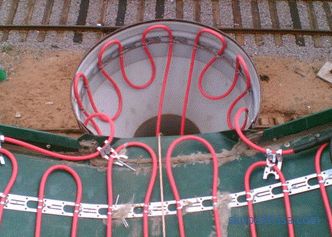
It might be interesting! In the article read the following link about heating the roof.
Fastening methods
It is possible to fix the heating cable to the roof with various devices. Most often for this use clips LST-S. These are different types of spring-loaded hooks through which the heating wire is passed. The clips themselves are attached to the roofing material with screws or adhesives. The main task of the manufacturer is to make as few holes as possible in the roofing material. Therefore, the place of tapping screws in the roof is recommended to be treated with a sealant, preferably silicone.
In the photo below one of the types of such clips is shown. The fastener is attached to the metal surface of the cornice with glue. And inside the gutters, plastic clips are used, which are attached at one end to the edge of the tray.
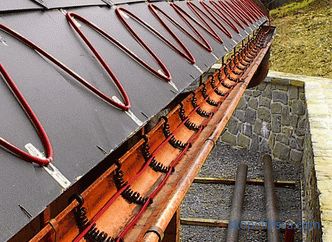
The heating conductor is not fixed inside the vertical pipes of the drainage system. It is fixed in the funnel and in the lower end of the pipe or inside the drain. The cable hangs freely inside the riser.
With regard to the method of fastening the heating element to the end valley plane, there are two options:
-
By stretching a steel string, you can use wires of different diameters. To do this, the latter is fixed on two sides: at the beginning and at the end, the valley ends, and they pull well.
-
Special fasteners that are attached to endova by adhesive.
The main requirement for this roof element is not to violate the integrity and integrity of the surface. Because on the endovo a large amount of water flows. And the holes in it - a high probability of leakage.
Video on the installation of the heating wire on the roof and gutter:
Connecting the heating cable
This operation must be carried out carefully .
-
Remove plastic insulation.
-
Along the cut the screen braid, turning it into a bundle.
-
Cut off the bottom insulation layer.
-
The matrix is cut to a length of 3 cm.
-
The conductors of the power cable are also cleaned of insulation.
-
They make the connection of the wires in pairs using a thermotube. This is a plastic tube into which the core of the heating conductor is inserted on one side. It is pulled out from the opposite side of the tube and connected to the core of the supply wire. The connection is made by soldering. Then the thermotube is tensioned at the joint and heated by a hairdryer. It expands, becomes soft, and after cooling decreases in size, squeezing the conductors among themselves. The thermotube performs the function of isolation.
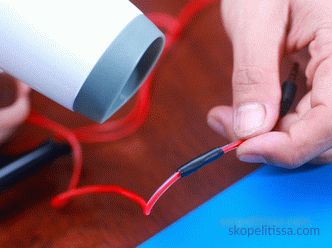
-
Thus are connected two cores each. And then two of them immediately clamp the sleeve, which will protect the connection from mechanical loads.
The power cord is connected to an AC mains with a voltage of 220 volts. An RCD is installed between the connection point and the wire. This device will protect the entire system from stray currents that appear if the insulation of one of the elements of the anti-icing system has been broken. That is, even when you touch the wires of a person, the current does not strike.
Please note that anti-icing is a grounded system. Therefore, the screened braid rolled into a bundle is connected to the grounding conductor of the supply wire in the same way as the wiring. In this case, two conductors (zero and phase) are connected by one sleeve, grounding the circuit of the other.
With regard to the network connection, the anti-icing system does not require difficulties. It consumes little electricity, so an ordinary outlet will be enough. Although other options are not prohibited. For example, to the switchboard through the machine.
Connection of the heating cable for heating the roof to the network in the video:
It might be interesting! In the article next link read about snegozaderzhateli on the roof.
Generalization on the topic
Heating of drains and gutters, roof eaves and valleys is a system that makes it possible to avoid such problems as the appearance of icicles on the roof and frost inside the drainage system. This means that the problems associated with the fall of ice and the avalanche of snow disappear, which lead to the death of people, injury and damage to property.
